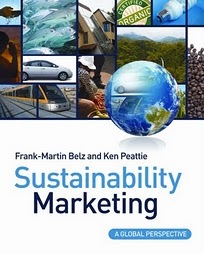 A review of the textbook Sustainability Marketing: A Global Perspective – the idea that a business degree can help better the world.
A review of the textbook Sustainability Marketing: A Global Perspective – the idea that a business degree can help better the world.
Ahhh. Remember that first day of college? Young. Naive. You think you can change the world. Then, your parents start bugging you about choosing a career and so you major in business and leave the world-changing ideas in the past.
But do you have to choose one or the other? Can you get your business degree and then set off to save the world? You can if your professor is Dr. Frank-Martin Belz or Ken Peattie, the co-authors of Sustainability Marketing: A Global Perspective.
Released just 10 months ago, the textbook has already sold 1,500 copies and been adopted by universities in the United States, Canada, UK, Australia, Germany, Switzerland, Austria, Sweden, Austria and more. Sales have been “far more than we expected or the publisher calculated,” said Dr. Belz, Professor at the Technische Universitaet Muenchen.
Publisher Wiley sent me a review copy of the book and the mission of the authors is made clear in the preface. The 25 years that preceded the book were marked by the Brundtland Report, the Millennium Goals, An Inconvenient Truth, the Stern report and the 2008 economic meltdown, which demonstrated that our existing way of living and doing business was economically, as well as environmentally, unsustainable.
That way of living and doing business is accompanied enabled by conventional marketing that continues to exist within an economic hyperspace in which there are no physical limits on the availability of resources or on the number of holes that waste can be poured. It is largely for this reason, that marketing is a discipline in crisis.
The authors want their students to aspire to something greater and for sustainability marketing to become mainstream. They define sustainability marketing as marketing that lasts forEVER, an acronym that stands for: ecologically oriented, viable, ethical and relationship-based.
To show where they want to go, the authors look at the history of green marketing and the emergence of sustainability marketing. It started in the 1970’s with ecological marketing that dealt mainly with the depletion of energy and nonenergy natural resources and the pollution created as a by-product of production and consumption. Ecological marketing sprang from Rachel Carson’s Silent Spring and Limits of Growth by the Club of Rome and inspired pioneering companies like the Body Shop and Ben & Jerry’s.
That was followed by green marketing and environmental marketing in the late 1980’s, which was focused on green consumers who would be willing to pay premium prices for more environmentally friendly products. Although this was more significant than the ecological marketing of the 1970’s, it had two problems that limited its success. The first was that “green” was more difficult to define than most product attributes and thus difficult to establish competitive advantage on. And the second was that the green consumer frequently proved to be something of a myth and the opportunities for green marketing proved to be far less than had been predicted in the early 1990’s. But both were, at their heart, simply continuations of conventional marketing and did nothing to make society more sustainable.
Now, the authors want a new kind of green marketing to become the dominant paradigm: sustainability marketing. This new green marketing embraces the idea of sustainable development, seeking to build and maintain sustainable relationships with customers, the social environment and the natural environment.
The role for this marketing is an exciting and important one. It is nothing less than changing the world. Progress toward sustainability will take a change of our existing dominant social paradigm and it will take persuasive communications for that shift to occur. Belz & Peattie have an audacious goal for marketing and it involves transforming it from a pusher of conspicuous consumption to a catalyst for sustainable development. As they say in the final chapter:
Some commentators argue that escaping from the unsustainable nature of contemporary capitalism and its commodity culture will require exactly the same type of persuasive communications and marketing efforts that have been used to promote consumption to be employed instead to promote alternative, less consumption-oriented lifestyles and behaviors.
It’s similar to the goal that John Grant has set out in the Green Marketing Manifesto: that the role of green marketing is to make the green seem normal. Is it achievable? Perhaps the career trajectory of Dr. Belz provides a ray of hope. In an email, he said that it was about ten years ago that my colleagues tried to talk me out of exotic”, “ethical” subjects such as sustainability and marketing (advising me to conduct “serious”, conventional marketing research). With all the interest in green marketing these days, it’s no surprise that Belz is glad he followed his heart and conscience. Perhaps he and Peattie will play a role in convincing the rest of society to follow their lead.
Belz and Peattie intended the book for three different audiences: students, those working in marketing research or business intelligence and corporate marketers. Maybe it was the old teaching assistant in me, but I really enjoyed it. Each chapter is bookended by company profiles and includes many of the things you would expect from a college textbook: key terms, review questions and discussion questions. I would have loved this book if it had been around when I was in school.
If you’re interested in the latest on green marketing with an academic flavor, follow the authors at their blog Sustainability Marketing. Or, like Rodney Dangerfield, you could go back to school at one of the universities using their textbook and really learn how to change the world.
Follow Nathan Schock on Twitter @nathanschock.


